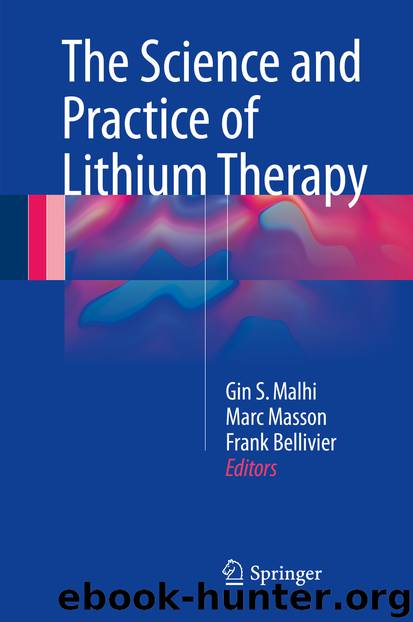The Science and Practice of Lithium Therapy by Gin S. Malhi Marc Masson & Frank Bellivier

Author:Gin S. Malhi, Marc Masson & Frank Bellivier
Language: eng
Format: epub
Publisher: Springer International Publishing, Cham
9.5 Brain Lithium Pharmacokinetics
Animal studies provide abundant direct and indirect evidence to support regional variations in the brain distribution of lithium. Twenty-four hours after a single subcutaneous lithium injection, heterogeneous lithium distribution was observed among rat brain regions, with the hypothalamus, corpus striatum, and midbrain being the regions with the highest lithium accumulation (Rios and Guzman-Mendez 1990). After the administration of 3 mEq/kg lithium chloride, the hypothalamus exhibited the highest concentration between 0.5 and 8 h, and after 8 h, the highest concentration was observed in the caudate nucleus, followed by the cortex and rest of the diencephalon (Mukherjee et al. 1976). Heterogeneous lithium distribution in rat brain regions at therapeutic dosages after prolonged treatment has also been reported (Ramaprasad 2004). Significant differences were found in vivo among lithium concentration ratios for the various brain regions, using either lithium-7 (7Li) MR spectroscopic imaging technology or in vitro methods (Komoroski et al. 1997).
Not only is lithium’s brain distribution heterogeneous, but its activity at a molecular level also exhibits high variability. Lithium appears to be most active in a region stretching from the anterior cingulate cortex and striatum to the caudal midbrain, with the greatest activity in the preoptic area and hypothalamic regions (Ramaprasad et al. 2005). Only some activity was observed in prefrontal cortex, and the lowest molecular activity was observed in the cerebellum and metencephalic brainstem. Accordingly, in rats chronically fed with a diet containing 0.2 % lithium carbonate, myo-inositol monophosphatase-1 activity increased substantially in various brain regions analysed, even doubling in some regions, in the following order: hippocampus > cerebellum > striatum > cerebral cortex > brainstem (Parthasarathy et al. 2003). In addition, the effect of 1, 2 and 4 weeks of lithium treatment (1 mmol/kg/day, intraperitoneal) on the myo-inositol concentrations across several rat brain regions, including the prefrontal, temporal and occipital cortical areas, as well as the hippocampus, was analysed using MRS at 18.8 T (McGrath et al. 2006). However, while other studies suggest brain region-specific alterations in myo-inositol concentrations among bipolar patients, this study found that lithium-induced reduction of myo-inositol is more global.
Excellent opportunities have emerged using MRS at high magnetic fields to image brain lithium-7 with unprecedented sensitivity (Lee et al. 2012; Renshaw et al. 1985). Lithium’s distribution in the brain, the mechanisms influencing lithium brain distribution, and lithium’s mechanism of molecular action in these different regions are important questions that need to be addressed, and answers to these questions may help to identify sensitive and specific biomarkers of lithium response.
The brain pharmacokinetics of lithium does not follow its plasma pharmacokinetics (time to reach maximal concentration and elimination half-life), suggesting active mechanisms underlying the distribution of lithium through the brain barriers; to date, the role of the blood-brain barrier (BBB) and the blood-cerebrospinal fluid barrier (BCSFB) in brain lithium PK-PD relationships has never been studied. Moreover, these transport mechanisms through the brain barriers, due to their region-specific expression and/or activity, may be responsible for the heterogeneity in lithium’s brain distribution. Interestingly, the Na+-dependent Cl−/HCO3 − exchanger
Download
This site does not store any files on its server. We only index and link to content provided by other sites. Please contact the content providers to delete copyright contents if any and email us, we'll remove relevant links or contents immediately.
Rewire Your Anxious Brain by Catherine M. Pittman(18312)
Talking to Strangers by Malcolm Gladwell(12878)
The Art of Thinking Clearly by Rolf Dobelli(9919)
Mindhunter: Inside the FBI's Elite Serial Crime Unit by John E. Douglas & Mark Olshaker(8707)
Becoming Supernatural by Dr. Joe Dispenza(7838)
Change Your Questions, Change Your Life by Marilee Adams(7381)
The Road Less Traveled by M. Scott Peck(7281)
Nudge - Improving Decisions about Health, Wealth, and Happiness by Thaler Sunstein(7247)
The Lost Art of Listening by Michael P. Nichols(7164)
Mastermind: How to Think Like Sherlock Holmes by Maria Konnikova(6938)
Enlightenment Now: The Case for Reason, Science, Humanism, and Progress by Steven Pinker(6877)
Win Bigly by Scott Adams(6829)
The Way of Zen by Alan W. Watts(6290)
Daring Greatly by Brene Brown(6228)
Big Magic: Creative Living Beyond Fear by Elizabeth Gilbert(5359)
Grit by Angela Duckworth(5302)
Men In Love by Nancy Friday(4965)
Ego Is the Enemy by Ryan Holiday(4960)
Altered Sensations by David Pantalony(4868)
